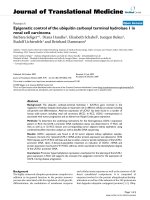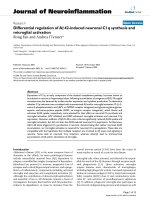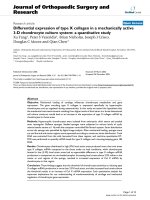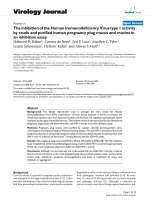Báo cáo hóa học: "Solvothermal Synthesis of Ternary Sulfides of Sb2 (x 5 0.4, 1) with 3D Flower-Like Architectures" ppt
Bạn đang xem bản rút gọn của tài liệu. Xem và tải ngay bản đầy đủ của tài liệu tại đây (547.14 KB, 6 trang )
NANO EXPRESS
Solvothermal Synthesis of Ternary Sulfides of Sb
2 2 x
Bi
x
S
3
(x 5 0.4, 1) with 3D Flower-Like Architectures
Jiquan Sun
•
Xiaoping Shen
•
Lijun Guo
•
Guoxiu Wang
•
Jinsoo Park
•
Kun Wang
Received: 19 May 2009 / Accepted: 31 October 2009 / Published online: 13 November 2009
Ó to the authors 2009
Abstract Flower-like nanostructures of Sb
2 - x
Bi
x
S
3
(x = 0.4, 1.0) were successfully prepared using both
antimony diethyldithiocarbamate [Sb(DDTC)
3
] and bis-
muth diethyldithiocarbamate [Bi(DDTC)
3
] as precursors
under solvothermal conditions at 180 °C. The prepared
Sb
2 - x
Bi
x
S
3
with flower-like 3D architectures were char-
acterized by X-ray diffraction (XRD), scanning electron
microscopy (SEM), energy dispersive X-ray spectrometry
(EDS), high-resolution transmission electron microscopy
(HRTEM), and selected area electron diffraction (SAED).
The flower-like architectures, with an average diameter
of *4 lm, were composed of single-crystalline nanorods
with orthorhombic structures. The optical absorption prop-
erties of the Sb
2 - x
Bi
x
S
3
nanostructures were investi-
gated by UV–Visible spectroscopy, and the results
indicate that the Sb
2 - x
Bi
x
S
3
compounds are semicon-
ducting with direct band gaps of 1.32 and 1.30 eV for
x = 0.4 and 1.0, respectively. On the basis of the exper-
imental results, a possible growth mechanism for the
flower-like Sb
2 - x
Bi
x
S
3
nanostructures is suggested.
Keywords Nanostructures Á Semiconductor Á
Ternary sulfide Á Solvothermal Á Optical properties
Introduction
Semiconductor nanocrystals have attracted much attention
in the past few decades [1, 2]. Among them, binary chalco-
genide semiconductors of the A
2
V
E
3
VI
type (A=Sb, Bi; E=S,
Se, Te) have aroused great interest due to their potential and
practical applications in thermoelectric and optoelectronic
devices. For example, bismuth sulfide (Bi
2
S
3
), which crys-
tallizes in the orthorhombic system, is a direct band gap
semiconductor with E.
g.
= 1.3 eV and can be applied in
photovoltaic converters [3] and thermoelectric cooling
technologies based on the Peltier effect [4]. At the same time,
Bi
2
S
3
nanocrystalline films have been found to significantly
alter the performance of photochemical cells due to quantum
size effects [5]. Moreover, antimony sulfide (Sb
2
S
3
), which
is isostructural to Bi
2
S
3
, shows interesting high photosensi-
tivity and high thermoelectric power [6], and its direct band
gap of 1.5–2.50 eV covers the visible and near infrared range
of the solar spectrum [7–9]. As a result, Sb
2
S
3
has wide
applications in solar energy conversion, thermoelectric
cooling technologies, television cameras, microwave devi-
ces, switching devices, rechargeable storage cells, and
optoelectronics in the infrared (IR) region [10–13].
The band gap of a material determines its applicability
as an optoelectronic material; therefore, tailoring of the
band gap is very helpful. A usual approach to adjust the
band gap is to synthesize materials on the nanoscale to take
advantage of the quantum confinement effect. However,
due to the low Bohr radius of most materials, the method is
often far from effective. As an alternative, the band gap can
also be tailored by adjusting the composition of materials.
It is well known that in doped compound semiconductors,
in contrast to undoped ones, the impurity states play a
special role in the electronic energy structures and transi-
tion probabilities [14]. For doped nanocrystalline
J. Sun Á X. Shen (&) Á L. Guo Á K. Wang
School of Chemistry and Chemical Engineering,
Jiangsu University, 212003 Zhenjiang, China
e-mail:
G. Wang Á J. Park
School of Mechanical, Materials and Mechatronics Engineering,
University of Wollongong, Wollongong, NSW 2522, Australia
123
Nanoscale Res Lett (2010) 5:364–369
DOI 10.1007/s11671-009-9489-1
semiconductor compounds, confinement effects in the
energy states also produce unusual physical and optical
behavior. Recently, several research groups have reported
the effects of the composition on the quantum efficiency of
Zn
1 - x
Mn
x
S and Cd
x
Zn
1 - x
S nanoparticles [15–18]. In
this paper, for the first time, we report the synthesis and
band gap of Bi-doped Sb
2
S
3
ternary sulfides, Sb
2 - x
Bi
x
S
3
(x = 0.4, 1.0) with flower-like nanostructures, prepared by
a facile solvothermal method.
Experimental
All the chemical reagents used in our experiments were of
analytical grade and were used without further purification.
The molecular precursors, antimony and bismuth diethyl-
dithiocarbamate, Sb(DDTC)
3
and Bi(DDTC)
3
, were pre-
pared as follows: 0.01 mol of SbCl
3
[or Bi(NO
3
)
3
] and
0.02 mol of (C
2
H
5
)
2
NCS
2
NaÁ3H
2
O were dissolved in
100 mL of distilled water, respectively. Then, the two
solutions were mixed by stirring in a 500-mL beaker. The
resulting white precipitates were filtered, washed with
distilled water, and dried in air at 60 °C.
In a typical procedure for synthesizing Sb
2 - x
Bi
x
S
3
, the
molecular precursors of Sb(DDTC)
3
and Bi(DDTC)
3
in the
appropriate ratios (1 mmol in all) were put into a Teflon-
lined stainless steel autoclave (30 mL capacity) to which
20 mL of ethylene glycol was added. The autoclave was
sealed and maintained at 180 °C for 12 h; then it was
allowed to cool to room temperature naturally. The as-
formed black precipitates were separated by centrifugation,
washed with ethanol and distilled water several times, and
dried at 60 °C for 3 h.
The phase of the as-synthesized products was character-
ized using X-ray diffraction (XRD, Shimadzu XRD-6000)
with Cu Ka radiation (k = 1.5406 A
˚
) at a scanning rate of
48 min
-1
. The X-ray tubes were operated with electric cur-
rent of 30 mA and voltage of 40 kV. The composition,
morphology, and sizes of the products were examined by
field emission scanning electron microscopy (FESEM; JSM-
7001), energy dispersive X-ray spectroscopy (EDS), and
transmission electron microscopy (TEM; JEOL-2100).
Samples for TEM were prepared by dropping the products on
a carbon-coated copper grid after ultrasonic dispersion in
absolute ethanol. The band gap energy of the products was
determined from the onset of the absorbance spectra of the
samples on a UV–Visible (UV–Vis) spectrophotometer with
near IR (NIR) capability (Shimadzu UV-4100).
Results and Discussion
Figure 1 shows the XRD patterns of the as-synthesized
products, and the diffraction peaks of both Sb
2 - x
Bi
x
S
3
samples can be indexed as orthorhombic phase structures
with lattice constants of a = 11.182 A
˚
, b = 11.378 A
˚
,
and c = 3.991 A
˚
, and a = 11.151 A
˚
, b = 11.375 A
˚
, and
c = 4.026 A
˚
for x = 0.4 and 1.0 (Sb
1.6
Bi
0.4
S
3
and
SbBiS
3
), respectively. The XRD patterns are consistent
with the orthorhombic phases Sb
2
S
3
(JCPDS: 42-1393)
and Bi
2
S
3
(JCPDS: 17-0320). EDS analyses were
employed to determine the chemical composition of
the products. The EDS spectra (Fig. 2a, b) taken from
the nanoflowers in SEM measurements show that both the
samples are composed of S, Bi, and Sb elements with
molar ratios (Bi:Sb) of about 1:4 and 1:1, respectively. To
clarify whether the nanorods were pure Sb
2 - x
Bi
x
S
3
or a
mixture of Bi
2
S
3
and Sb
2
S
3
, EDS from individual nano-
rods was examined using TEM. As shown in Fig. 2c and
d, each of the nanorods contained S, Bi, and Sb elements
with a molar ratio similar to the case in SEM. The signals
for Cu and C in the EDS spectra came from the carbon-
coated copper grid used for TEM measurement. These
results confirmed the successful preparation of bismuth
and antimony ternary sulfides.
The overall morphology of the Sb
1.6
Bi
0.4
S
3
is shown
in Fig. 3a, which illustrates that the obtained products
consist of a large number of flower-like nanostructures.
After careful observation (Fig. 3b), it was found that the
flower-like architectures consist of several nanorod bun-
dles that are *4 lm in length and extend toward many
different directions. Furthermore, every nanorod bundle
is made up of nanorods with a diameter of *80 nm. The
overall morphology of the SbBiS
3
is shown in Fig. 3c. It
can be seen that similar to the Sb
1.6
Bi
0.4
S
3
, the SbBiS
3
products also consist of a large number of flower-like
10 20 30 40 50 60 70
Intensity (a.u)
2
θ
/ degree
(120)
(220)
(130)
(211)
(221)
(301)
(311)
(240)
(231)
(141)
a
b
(020)
(421)
(501)
(160)
(312)
(161)
(361)
(152)
(522)
Fig. 1 XRD patterns of the flower-like Sb
2 - x
Bi
x
S
3
: (a) x = 0.4; (b)
x = 1
Nanoscale Res Lett (2010) 5:364–369 365
123
nanostructures. However, as shown in Fig. 3d, the
flower-like architectures of SbBiS
3
have a highly regular
sphere-like morphology, which is obviously different
from that of Sb
1.6
Bi
0.4
S
3
. The sphere-like structure with
an average diameter of about 4 lm is composed of large
numbers of nanorods, which grow radially from the
central core and have a length of 2 lm and a diameter
of about 100 nm.
Fig. 2 EDS spectra of the
Sb
2 - x
Bi
x
S
3
nanoflowers and
individual nanorods shown in
the respective insets:
a, c x = 0.4; b, d x = 1
Fig. 3 FESEM images of the flower-like Sb
2 - x
Bi
x
S
3
: a, b x = 0.4; c, d x = 1
366 Nanoscale Res Lett (2010) 5:364–369
123
A further investigation of the Sb
2 - x
Bi
x
S
3
products was
made by TEM. Figure 4a shows a typical TEM image of
Sb
1.6
Bi
0.4
S
3
flower-like architectures, which is consistent
with the FESEM observations. After long ultrasonic treat-
ment during the preparation of the TEM specimens, the
flower-like structures were substantially unaffected. This
suggests that the formation of the flower-like architectures
is not due to aggregation. The microstructures of the
Sb
1.6
Bi
0.4
S
3
nanorods were investigated by high-resolution
TEM (HRTEM) and selected area electron diffraction
(SAED). The SAED pattern (Fig. 4b) taken from an indi-
vidual nanorod indicated in the inset shows regular dif-
fraction spots, which can be indexed as a orthorhombic
Sb
1.6
Bi
0.4
S
3
single crystal recorded from the [11–1] zone
axis and demonstrates that the Sb
1.6
Bi
0.4
S
3
nanorod grows
along the [1-10] direction. As shown in Fig. 4c, the
HRTEM image of the Sb
1.6
Bi
0.4
S
3
nanorod shows clear
lattice fringes with a d-spacing of 0.79 nm, which corre-
sponds to the (110) lattice distance. Figure 4d shows a
TEM image of the SbBiS
3
sample. It can be seen that the
SbBiS
3
has a perfect sphere-like architecture consisting of
nanorods, which is agreement with the FESEM observa-
tions. The nanorods extend radially from the central core
and have less regular shapes (Fig. 4e). The SAED pattern
(inset in Fig. 4e) taken from an individual nanorod shows
that the SbBiS
3
nanorod is single-crystalline. Figure 4f
Fig. 4 TEM, HRTEM, and SAED images of the Sb
2 - x
Bi
x
S
3
: a–c x = 0.4; d–f x = 1
Nanoscale Res Lett (2010) 5:364–369 367
123
depicts a HRTEM image of the SbBiS
3
nanorod. The clear
lattice fringes with a d-spacing of 0.31 nm are consistent
with that of the (211) planes of orthorhombic SbBiS
3
,
further confirming that the SbBiS
3
nanorod is single-
crystalline.
In our previous study, Bi(DDTC)
3
and Sb(DDTC)
3
have
been used as single-source molecular precursors for the
syntheses of Bi
2
S
3
[19] and Sb
2
S
3
[20] nanomaterials,
respectively. Considering the highly similar crystal struc-
tures of Bi
2
S
3
and Sb
2
S
3
, we herein synthesized ternary
sulfides Sb
2 - x
Bi
x
S
3
by using both Bi(DDTC)
3
and
Sb(DDTC)
3
as precursors in a one-pot reaction. Based on
the experimental observations, we infer that the formation
process of the flower-like Sb
2 - x
Bi
x
S
3
nanostructures can
be divided into three steps: First, under the solvothermal
action, the precursors of Bi(DDTC)
3
and Sb(DDTC)
3
were
decomposed and produced Sb
2 - x
Bi
x
S
3
, which would
form Sb
2 - x
Bi
x
S
3
crystal nuclei when the degree of
supersaturation of the Sb
2 - x
Bi
x
S
3
reached a certain crit-
ical point. Secondly, these crystal nuclei grew and/or
aggregated into a bigger core, which was thermodynami-
cally favorable due to the decrease in the surface energy.
Finally, the as-formed cores may serve as the substrates for
epitaxial growth of the Sb
2 - x
Bi
x
S
3
nanorods. As a result,
the flower-like architecture with Sb
2 - x
Bi
x
S
3
nanorods on
its surface was formed. To check the proposed mechanism,
we have done several parallel experiments with shorter
reaction time of 10 and 6 h with the other synthetic con-
ditions remaining unchanged. It was found that with the
decrease of the reaction time, there were more separated
nanorods in the products. This result is consistent with the
formation mechanism of the Sb
2 - x
Bi
x
S
3
flowers.
Optical absorption experiments were carried out to
elucidate the band gap energy, which is one of the most
important electronic parameters for semiconductor
nanomaterials. Figure 5 shows typical UV–Vis absorption
spectra of the two samples. The k
onset
of the spectra
recorded from the two samples are about 940 and 955 nm
for x = 0.4 and 1.0, respectively. The band gap of the
Sb
2 - x
Bi
x
S
3
may be estimated using the following
formula:
ðahmÞ
2
¼ Bðhm ÀE
g
Þð1Þ
where, a is the absorption coefficient, hm is the photon
energy, B is a constant characteristic of the material, and
E.
g.
is the band gap. The value of hm extrapolated to a = 0
gives the absorption band gap energy. The band gaps of the
Sb
2 - x
Bi
x
S
3
are calculated to be 1.32 and 1.30 eV for
x = 0.4 and 1.0, respectively, which are smaller than the
values reported for pure Sb
2
S
3
, but are near to that of
Bi
2
S
3
. The change in band gap energy probably result from
the change in the composition of the Sb
2 - x
Bi
x
S
3
, since
the flower-like Sb
2 - x
Bi
x
S
3
nanostructures in our dimen-
sional range should not show a quantum confinement effect
due to the low Bohr radius of these materials. The flower-
like Sb
2 - x
Bi
x
S
3
nanostructures with a narrow band gap
may be very promising for applications in solar energy and
photoelectronics.
Conclusions
In summary, we have developed a facile and mild solvo-
thermal method for the large-scale preparation of ternary
sulfide Sb
2 - x
Bi
x
S
3
(x = 0.4, 1.0) flower-like nanostruc-
tures. The possible formation mechanism of the flower-like
Sb
2 - x
Bi
x
S
3
is suggested. The optical properties of the
Sb
2 - x
Bi
x
S
3
products were evaluated by UV–Vis spec-
troscopy at ambient temperature. The results indicate that
the Sb
2 - x
Bi
x
S
3
compounds are semiconducting with
direct band gaps of 1.32 and 1.30 eV for x = 0.4 and 1.0,
respectively. This method can probably be extended to the
600 700 800 900 1000 1100 1200 1300 1400
600 700 800 900 1000 1100 1200 1300 1400
0.0
0.2
0.4
0.6
0.8
1.0
1.2
Wavelength (nm)
Absorbance (a.u.)
0
1
2
3
4
5
E
g
=1.32 eV
(
αhν)
2
(a.u.)
hν (eV)
a
0.0
0.2
0.4
0.6
0.8
1.0
1.2
1.4
0.0 0.5 1.0 1.5 2.0 2.5 3.0
0.0
0.5
1.0
1.5
2.0
2.5 3.0
0
1
2
3
4
5
h
ν (eV)
(α
hν)
2
(a.u.)
E
g
=1.30 eV
Wavelen
g
th (nm)
Absorbance (a.u.)
b
Fig. 5 UV–Vis spectra of the Sb
2 - x
Bi
x
S
3
: a x = 0.4; b x = 1. The
insets contain the corresponding (ahm)
2
versus hm curves
368 Nanoscale Res Lett (2010) 5:364–369
123
fabrication of other ternary sulfide semiconductors nano-
structures with various morphologies and functions.
Acknowledgments We are grateful for financial support from the
Natural Science Foundation of Jiangsu Province (No. BK2009196) and
the National Natural Science Foundation of China (No. 20875039).
References
1. K.J. Tang, J.N. Zhang, W.F. Yan, Z.H. Li, Y.D. Wang, W.M.
Yang, Z.K. Xie, T.L. Sun, H. Fuchs, J. Amer. Chem. Soc. 130,
2676 (2008)
2. Y. Liu, Q. Shen, D. Yu, W. Shi, J. Li, J. Zhou, X. Liu, Nano-
technology 19, 245601 (2008)
3. J. Black, E.M. Conwell, L. Seigle, C.W. Spencer, J. Phys. Chem.
Solids 2, 240 (1957)
4. B.X. Chen, C. Uher, L. Iordanidis, M.G. Kanatzidis, Chem.
Mater. 9, 1655 (1997)
5. R.S. Mane, B.R. Sankapal, C.D. Lokhande, Mater. Chem. Phys.
60, 196 (1999)
6. Y. Yu, R.H. Wang, Q. Chen, L.M. Peng, J. Phys. Chem. B 109,
23312 (2005)
7. B. Roy, B.R. Chakraborty, R. Bhattacharya, A.K. Dutta, Solid
State Commun. 25, 937 (1978)
8. O. Savadogo, K.C. Manda, Solar Cells 26, 117 (1992)
9. M.T.S. Nair, Y. Pena, J. Campos, V.M. Garica, P.K. Nair, J.
Electrochem. Soc. 141, 2113 (1998)
10. J. Geroge, M.K. Radhakrishnan, Solid State Commun. 33, 987
(1980)
11. O. Savadogo, K.C. Mandal, Electron. Lett. 28, 1682 (1992)
12. A.M. Salem, M.S. Selim, J. Phys. D Appl. Phys. 34, 12 (2001)
13. K.Y. Rajpure, C.D. Lokhande, C.H. Bhosale, Mater. Res. Bull.
34, 1079 (1999)
14. Y.L. Soo, Z.H. Ming, S.W. Huang, Y.H. Kao, Phys. Rev. B 50,
7602 (1994)
15. D. Son, D.R. Jung, J. Kim, T. Moon, C.J. Kim, B. Park, Appl.
Phys. Lett. 90, 101910 (2007)
16. J.P. Ge, J. Wang, H.X. Zhang, X. Wang, Q. Peng, Y.D. Li, Adv.
Funct. Mater. 15, 303 (2005)
17. W.Z. Wang, I. Germanenko, Chem. Mater. 149, 3028 (2004)
18. D.V. Petrov, B.S. Santos, G.A.L. Pereira, C. de Mello Donega
´
,J.
Phys. Chem. B 106, 5325 (2002)
19. X.P. Shen, H. Zhao, Q. Liu, Z. Xu, Chin. J. Inorg. Chem. 23,
1561 (2007)
20. X.P. Shen, G. Yin, W.L. Zhang, Z. Xu, Solid State Commun. 140,
116 (2006)
Nanoscale Res Lett (2010) 5:364–369 369
123









